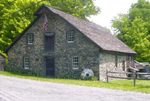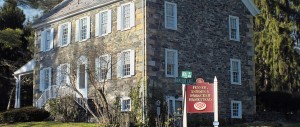
THE OLD MILL AT SCIOTA, PA
Brinker’s Mill, a log structure, may have been built as early as 1729, according to a news feature in the Stroudsburg Daily Record for April 16, 1954. Jacob Brinker was listed on the tax rolls of Hamilton Township as early as 1764.
The mill assumed prominence in 1779, when the Sullivan Expedition was dispatched by Congress “to chasten and humble” the Iroquois Indians. The Expedition left Easton on June 18; the mill served as a storehouse and advance post for this unit of some 4,000 men.
From Jacob Brinker the mill passed into the hands of John George Keller about 1790. With the passing of time the log mill had deteriorated. It was replaced in 1800 by the present structure, built by Bernhard Fenner. The mill, with its overshot wheel, was a sophisticated operation for its day, producing various types of flour as well as feed for stock. The services of two separate millers were required.
From the Fenner family the mill passed to a relative by marriage, George Snyder; then to Romanous Snyder; and from him to William Snyder. It ceased active milling operations in 1954.
The mill was next acquired by Eugene Haller, who sold it to Karl Hope. In 1974 Mr. Hope and his wife presented it to Hamilton Township with the stipulation that it should be “held and maintained… for historical, cultural, and/or governmental purposes.” The Hamilton Township Supervisors appointed an advisory body, charging them to make recommendations for restoration and future use of the mill. This body – the Old Mill Restoration Council, PO Box 285, Sciota, PA 18354
THE FENNER SNYDER ROBACKER HOMESTEAD
Circa 1805
The Fenner Snyder Robacker Homestead is situated at the corner of Neola Rd. and Business Rt. 209 in Sciota, PA. The homestead was willed to Hamilton Township in 1989 by Ada Robacker. It was built in 1805 by Barnett Fenner. Fenner sold the property to the Snyder family, who then sold it to the Robacker family. Earl and Ada Robacker were experts on Pennsylvania Dutch antiques, artwork, and publications. Today, the Fenner Snyder Robacker Homestead is used as an exhibition hall for history, art, antique, and government programs.
